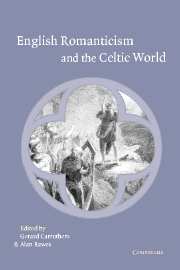Book contents
- Frontmatter
- Contents
- List of contributors
- Acknowledgements
- 1 Introduction: romancing the Celt
- 2 Sir William Jones, the Celtic Revival and the Oriental Renaissance
- 3 The critical response to Ossian's Romantic bequest
- 4 Blake and Gwendolen: territory, periphery and the proper name
- 5 The Welsh American dream: Iolo Morganwg, Robert Southey and the Madoc legend
- 6 Wordsworth, North Wales and the Celtic landscape
- 7 The force of ‘Celtic memories’ in Byron's thought
- 8 Shelley, Ireland and Romantic Orientalism
- 9 Byron and the ‘Ariosto of the North’
- 10 Scott and the British tourist
- 11 Felicia Hemans, Byronic cosmopolitanism and the ancient Welsh bards
- 12 Luttrell of Arran and the Romantic invention of Ireland
- 13 Contemporary Northern Irish poets and Romantic poetry
- Notes
- Bibliography
- Index
13 - Contemporary Northern Irish poets and Romantic poetry
Published online by Cambridge University Press: 22 September 2009
- Frontmatter
- Contents
- List of contributors
- Acknowledgements
- 1 Introduction: romancing the Celt
- 2 Sir William Jones, the Celtic Revival and the Oriental Renaissance
- 3 The critical response to Ossian's Romantic bequest
- 4 Blake and Gwendolen: territory, periphery and the proper name
- 5 The Welsh American dream: Iolo Morganwg, Robert Southey and the Madoc legend
- 6 Wordsworth, North Wales and the Celtic landscape
- 7 The force of ‘Celtic memories’ in Byron's thought
- 8 Shelley, Ireland and Romantic Orientalism
- 9 Byron and the ‘Ariosto of the North’
- 10 Scott and the British tourist
- 11 Felicia Hemans, Byronic cosmopolitanism and the ancient Welsh bards
- 12 Luttrell of Arran and the Romantic invention of Ireland
- 13 Contemporary Northern Irish poets and Romantic poetry
- Notes
- Bibliography
- Index
Summary
One might begin an essay that will sketch a general picture, before looking in more detail at Seamus Heaney's and, to a lesser degree, Derek Mahon's poetry, with James Joyce laying in to ‘romanticism’ (with a small ‘r’): ‘in realism you are down to facts on which the world is based: that sudden reality which smashes romanticism into a pulp. What makes most people's lives unhappy is some disappointed romanticism, some unrealizable or misconceived ideal.’ To the degree that Romantic poetry embodies the pursuit of an ‘unrealizable or misconceived ideal’, it tends to provoke opposition in contemporary Northern Irish poets, aware, among other things, of the political havoc caused by abstract idealism. John Montague, for instance, forcing himself in ‘Tim’ to ‘drink / from the trough of reality’, declares in The Rough Field that ‘No Wordsworthian dream enchants me here / With glint of glacial corrie, totemic mountain’. Still, Romantic poetry, as inaugurated by Lyrical Ballads, itself seeks to ‘choose incidents and situations from common life’, albeit with a ‘certain colouring of imagination’, and by means of ‘a selection of language really used by men’. Moreover, who is more alert to the way the ‘ideals’ may be ‘misconceived’ than poets such as Keats and Shelley? With some justice, Aidan Day contends that Alastor can be read as ‘a demonstration of the solipsistic emptiness of an inward-looking spiritual orientation’, even if it is the case that Shelley has an ‘inward’ sympathy with the Poet's need to image ‘to himself the Being whom he loves’.
- Type
- Chapter
- Information
- English Romanticism and the Celtic World , pp. 196 - 209Publisher: Cambridge University PressPrint publication year: 2003



